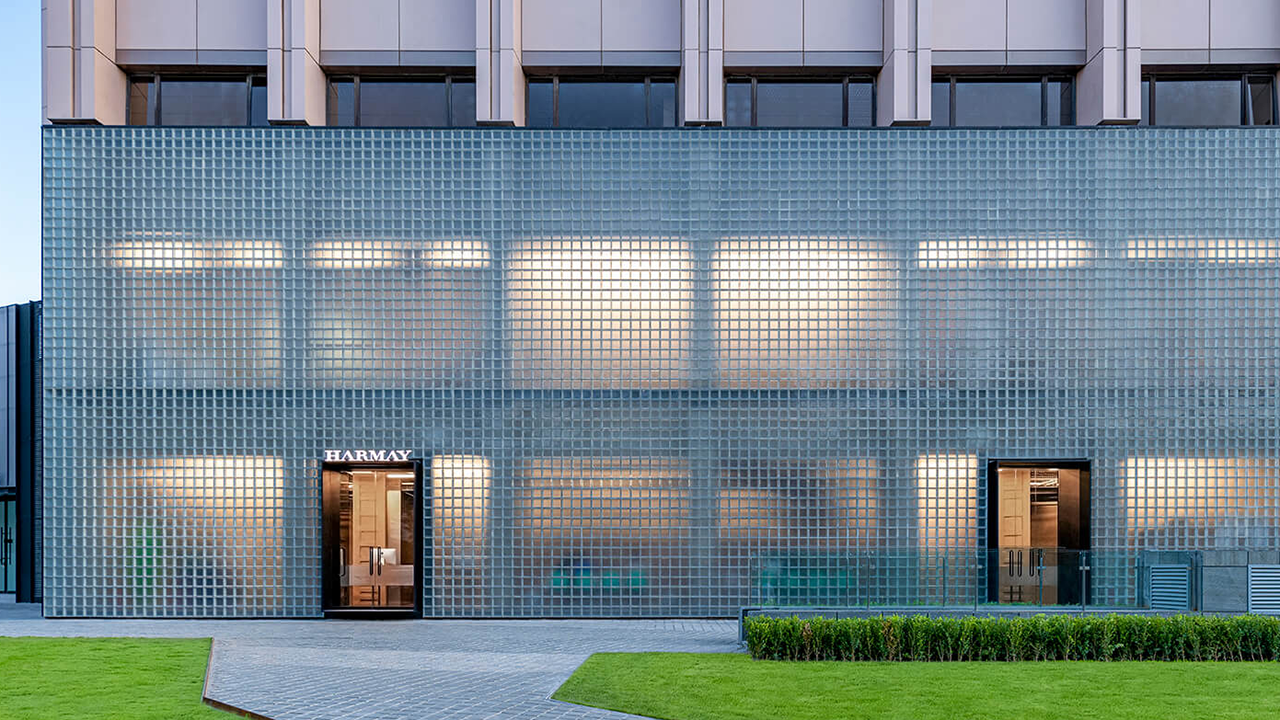- The sale of samples to build trust among skincare consumers is a tactic that is resonating well for Harmay. It allows customers the opportunity to trial the product without making a large investment. It speaks directly to the needs of their consumers and offers them a new way to purchase.
- Customers can now learn everything they need to know about products online. The traditional consultative model — where beauty advisers explain ingredients and offer advice — tends to be less appealing to today’s consumers who are more influenced by KOLs and KOCs.
- Where homegrown brands might lose out is the transparency of supply chains which determines the authenticity of their products. Therefore, the retail price advantage continues to be an issue for mainland consumers.
A bare concrete ceiling, rows of steel shelves interspersed with fluorescent lamps, and a spacious, open environment. These are the industrial elements that constitute Harmay’s Beijing flagship store. A high-end beauty Costco if you will. Products — from pricey skincare to entry-level lipstick — are grouped in the same way as they are in the warehouse. This eccentric presentation is fascinating local beauty shoppers as it challenges the sleek design found in department stores as well as beauty retailers like Sephora.
Launching as a cosmetics e-merchant on Taobao, the 11-year-old company has now expanded into a bona fide brand with brick-and-mortar stores in Hong Kong, Shanghai, and Beijing; it is still running e-shops on Taobao, Tmall, and now WeChat. Since opening its store in September 2019, the Beijing shop has topped the beauty retailer chart in the city on Dazhongdianping (the Chinese equivalent of Yelp) and frequently been tagged on apps like Little Red Book and Douyin. Its extensive transformation has earned both consumer and investor recognition. 36Kr, China’s leading publication with an unparalleled network in the startup ecosystem, reported the company achieved its Series A round financing led by Hillhouse Capital — the Venture Capital powered C-beauty senior player Perfect Diary.
Given the crowded beauty market in China, these achievements are by no means simply hype. Yet, what makes this homegrown retailer think it can compete with LVMH-owned Sephora and Watsons - the largest Asian beauty chain store? Indeed, what can other players eyeing the lucrative beauty pool learn about Chinese beauty shoppers from Harmay’s success? Jing Daily looks at the company from retail to marketing that is helping it to penetrate the country’s flourishing multi-brand beauty store sector.
Sample Economy#
Samples or mini-size beauty products are important touchpoints to improve brand relevance, attract new customers, and facilitate full-size sales. The reason is simple: skincare consumers prefer to try out pricey high-end products without a large investment while makeup or fragrance lovers want to try a variety of colors or scents at less cost: Samples are the perfect solution.
However, besides brands gifting their valued customers and releasing holiday sets, independent beauty samples can be found at few legitimate channels outside a flagship and beauty counters at department stores. Realizing today’s consumers are more cautious before decision-making, Harmay uses sample-selling to encourage consumers to try products at home instead of offering testers. Taking this root and by advocating slow shopping over obsessive consumerism, the company’s offline strategy opposes other industry players.
Even so, the transformation from e-commerce to brick-and-mortar business is an arduous one due mainly to new retail trends. Featuring warehouse-like merchandising, the Beijing store recreates the scene behind the cross-border e-commerce. “We want to let our customers know where the products they purchase come from,” Jason Ju, the co-founder of Harmay, explains the origins of the idea. This marriage of warehouse and samples is being popularized by the brand’s younger consumers who either have limited budgets or are searching for novel products.

Self-Service Model#
Today’s Chinese millennial and Gen Z consumers, different from the elder generations, are growing up in an age where consumers can learn everything they need to know about products on the Internet and via social media. The consultative model where beauty advisers follow customers, explain ingredients and functions, and share make-up expertise tends to be less appealing to today’s consumers.
Selling advanced labels like La Mer, La Prairie, and Valmont has not stopped Harmay from adopting a self-service model and minimizing sales tactics. “There is no beauty adviser who keeps on suggesting products or looks you up and down to evaluate if you can afford a 260 face cream, but there are few assistants around if you cannot find the product you are looking for,” says 24-year-old consumer Rona Wang sharing her experience after visiting the Hong Kong shop. She also commented on the “cool attitudes” of cashiers, adding, “they do not ask you to subscribe to the WeChat account as other beauty stores, which makes me feel less committed.”
Consumers’ recognition for the company’s unconventional strategy sheds light on high-end beauty consumer demographics in China’s market. Millennial and Gen Z women - the ultimate engine of luxury beauty - tend to be less hesitant to invest in pricey skincare however also less loyal to specific brands than older generations. As posts and videos featuring make-up instructions, product review, empties and so on, have spread across various social media platforms, it is clear that consumers’ decision-making is predominantly influenced by KOLs and KOCs instead of beauty advisors in-store.
Moreover, digital-savvy consumers are now used to researching products before purchasing. 85% of beauty consumers have made the purchasing decisions before entering sales channels, according to BCG x Tencent’s 2020 China Social Retail Report. This consumer behavior extends from online to offline too. As such, the self-service model is consistent with the process of online shopping yet offering immediate product pick-up.
Content Marketing#
Today’s consumers are empowered enough to choose what they want to read in the media and are savvy enough to identify specific marketing tactics. Conventional product-focused marketing content is shifting to a knowledge, idea, and perspective-oriented one. This trend is notable in the beauty industry as Chinese beauty consumers are inclined to self-educate on beauty skills and products. To captivate this group, the retailer leverages content-driven marketing, engaging followers seamlessly from content to products. The official WeChat account posts exemplify this strategy: “Gift list for Lunar New Year,” “What Men Wear Lipstick Look Like,” and “Makeup Transformation for Random Person” are either instructions or popular social experiments.
Alongside publishing posts on WeChat official account and Weibo for users, Harmay encourages consumers to create their own content spontaneously on social media. Known as one of the most popular “wanghong” retail stores thanks to its “instagrammability,” Harmay Beijing sees instant popularity on Little Red Book, which brings crazy traffic instore. Netizens who live in or visit Hong Kong, Shanghai, and Beijing are sharing their visiting experiences and photos online while residents from other provinces are calling for Harmay’s to expand.
Elsewhere, the cosmetic player’s private domain traffic has been soaring within the WeChat ecosystem, which leads to efficient monetization. Through confining the membership system to the WeChat official account, Harmay gathers potential content generators from its membership. The most recent post to reach 8,000 reads in two days is a Valentine’s Day gifting guide. After scrolling down a gift list, users can access products through attached links to the mini-program “Harmay Black Market,” the WeChat e-shop. It also features a discussion on ideal gifts for your partner on Valentine’s Day. Many readers responded and shared their plans for the day - despite the current coronavirus outbreak.
The expansion consumers have been calling for is now on the way: at the time of publication, Harmay’s Chengdu branch was planned to open during 2020 - indicating homegrown beauty retailers can have even better flexibility than prestigious beauty chains. They can easily track the hyped lipstick colors and other niche products, and adjust their inventory and marketing to accommodate any changes. However, the most outstanding issue for consumers is the transparency of supply chains which determines the authenticity of the product. The retailer’s price advantage has always been a highlight for mainland consumers who now await reliable clarification of where the products and price difference originate.


